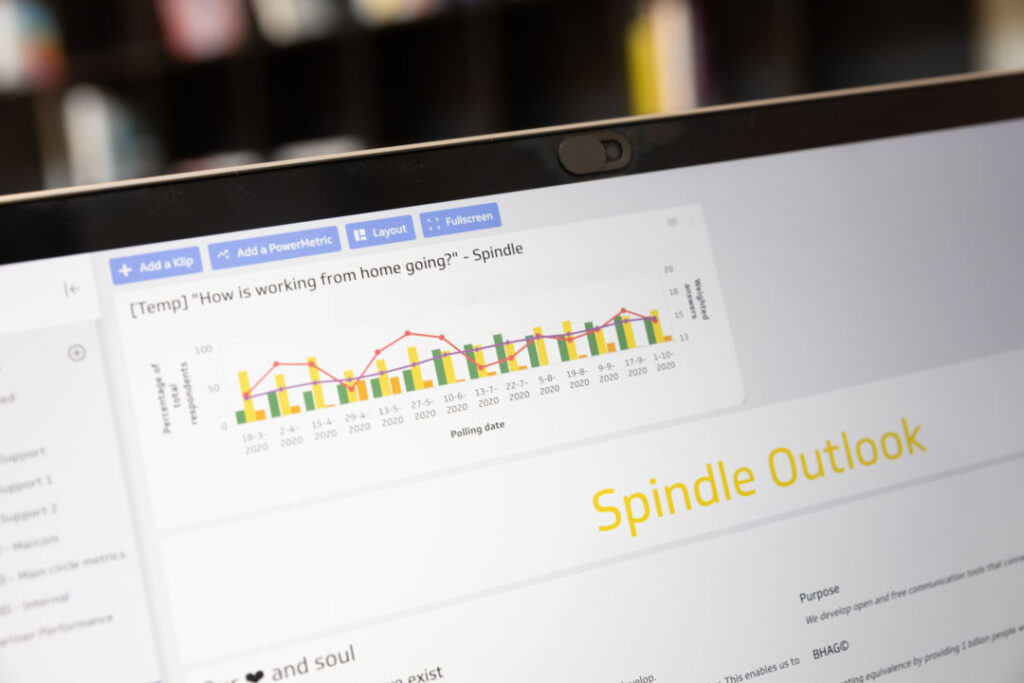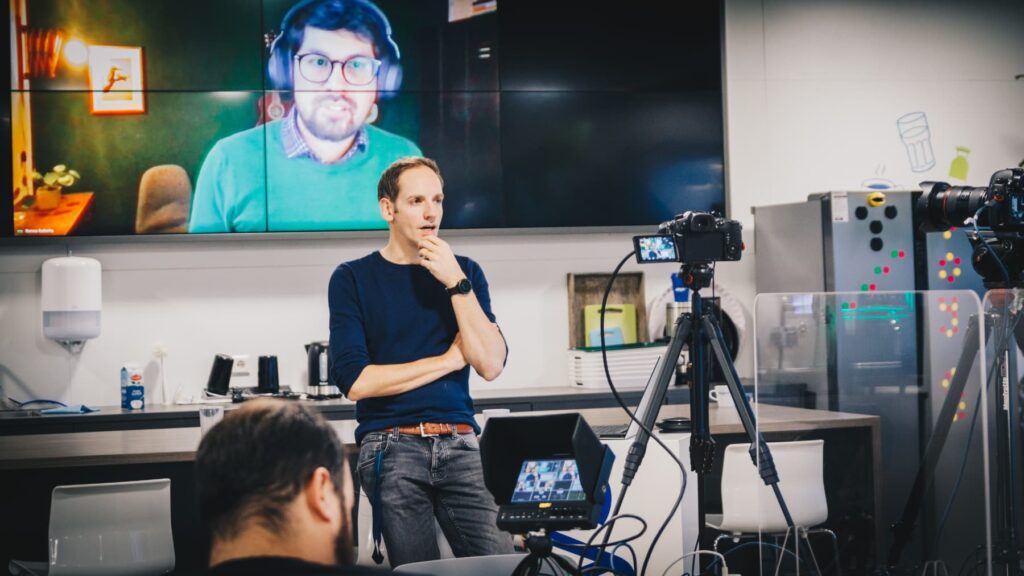What WordPress taught us about successfully implementing distributed work
Written by Mark Vletter on 15th February 2021
Learning from what others have already invented is one of the fastest ways to develop your organization. It’s like learning to play monopoly from the world champion. One of the world champions in the field of remote distributed work is, without a doubt, WordPress.com. Or rather: the company behind WordPress.com, Automattic. The 1300 people who work there have never been to the Automattic office – there is no such thing. They don’t have an office. I learned a few things about distributed work from the CEO of WordPress.com, Matt Mullenweg. In this article, I’ll share why I think distributed working is the future AND 3 tips to get it working in your organization.
Working from home during the pandemic
Thanks to the COVID-19 pandemic working from home is taking off, with all its challenges. Within our organization we also notice this: how do you make it work, if you are not in the same room with all your colleagues every day? Not only do we have more and more international colleagues, I also expect us to become a hybrid organization after the pandemic. 50% of our colleagues will continue to see the office as their primary workplace, where the other 50% will prefer to work from home. I predict that many companies will opt for this hybrid form in the future, but it does bring challenges.

Keeping track of our happiness at home during COVID-19
What is distributed working?
To know how to get something working for you, you first need to know what it is. Distributed working is a variation of the term “remote working” and is used by WordPress.com, among others. It’s a subtle difference, but it really changes how people feel. I believe that using the right language can evoke different behaviors and emotions. An example: we currently call keeping our distance “social distancing”. But I don’t want to do social distancing, I want to stay as close as possible socially. Physical distance, that I can understand. So then we should call it “physical distancing”.
The same applies to the word remote. Remote literally translates as distant, removed, and isolated. When we talk about working remotely, we are talking about “working removed and isolated”. This strikes me as extremely unhealthy for what an organization essentially is: a group of people trying to accomplish goals together. Remote has an element of loneliness and alone.
A better term is distributed work. There is an element of togetherness in distributed: a much healthier name in organizations trying to achieve goals together.
5 Levels of Distributed Work
According to Matt Mullenweg, the CEO of the company behind WordPress.com, there are 5 levels of Distributed Work. I summarize them briefly:
Level zero: work that can’t be distributed
Manufacturing, construction: these are examples of work that cannot be distributed. It is necessary to be physically present at a specific location to perform the work. Fun detail: this pandemic has taught us that “it can’t” turns out to be more elastic than expected. Telemedicine is a good example of this. In the past you had to go to the doctor with a spot on your skin, now sending a picture is sometimes enough. So the question is: is it really impossible, or is that all you think?
Level one: it works, but barely
Before the pandemic, most companies were at the first level: there was no conscious effort to regulate remote working. It was, presumably, not needed before. In an emergency – such as a pandemic – it works to keep things moving for a day or two, but it works far from optimally.
Level two: the remote copy of the office
Many companies are currently at level two. They have accepted that work must be done at home, but they are recreating what they did in the office. The only thing that has changed is the environment. Zoom and Teams are on all day and there are still just as many meetings, only digital. In companies that are at this level, we see that they are frenetically clinging to synchronous working. People are, because of this copy of the office, completely broken at the end of the day.
If you want to successfully implement distributed working in your organization, you will have to outgrow this level. This goes hand in hand with a lot of letting go. No longer do you have to constantly check whether people are working, but trust that the work will be done. No longer do you want to work in sync, but figure out how to work in an asynchronous way. Once you can do that, your organization can move on to the next level.
Level three: the benefits of distributed work become visible
Welcome to level three! Your workspace at home is finally set up properly . Your height adjustable desk is there, you’re sitting on a decent chair and you not only have a laptop, but also a second screen. A good headset and webcam have finally been arranged and of course you can make calls in the cloud ;).
Now that your gear is in order, you can improve the processes and software you use. There are fewer meetings and some asynchronous work can be done. During meetings, not only is the Zoom screen open but also a Google Drive document or a Notion page, in which multiple people make notes. This way, it is immediately clear if what is said by others is properly understood. Because everyone in the organization can read these notes later, fewer people need to be present at the meeting. Creative work can now also take place remotely: for these sessions you can use tools such as Google Jamboard, Mural or Miro.
Level four: truly asynchronous work
At level four, we no longer look at whether people are working, but at what has been produced. How and when that was done has become totally irrelevant. Trust is the magic word.
Decisions are made asynchronously. Introverts have more time to think, which allows them to add even more value. Also, decisions are of much better quality. This is partly due to the extra time to think, but also because broader input can be given. This means that decisions are better reasoned, which subsequently means that they are better processed and implemented.
At this level, you are no longer dependent on time and location. Your workforce can be anywhere in the world, not just in the Netherlands. This offers the possibility of becoming a 24/7 organization. Your organization is now truly inclusive: the standards are objective and people have the autonomy to do their work in the way that works best for them.
Level five: nirvana
This is the virtually unattainable nirvana. A situation where you have gone through all the levels above in such a way that it leads to consistently better performance than any non-distributed organization could.
Integrating distributed work into your organization
Now that you know what distributed working is and what level your organization is at, it’s time to get started. How do you get distributed working well integrated into your organization? Here are my 3 tips:
Tip 1: the need for recorded history for distributed working
To become a well-oiled distributed organization, capturing processes, decisions, and knowledge is essential. Clarity is everything in a distributed organization. By providing clear explanations of the choices being made and capturing it all, you facilitate working in distributed teams.
Matt (of Automattic) cites an example from WordPress.com: “If we want to add a widget to a page, such a decision often impacts the product we are developing even years later. A new colleague who has just been hired may decide that that widget is not useful and redesign it, but in doing so negates all the lessons from the past.” The WordPress founder calls their knowledge base of historical decisions one of the organization’s greatest assets!
When you “do a quick tune-up” in the office, it creates local synchronization. If you don’t digitally capture this decision or synchronization, you automatically put your distributed colleagues at a distance. So it makes sense to start integrating digital decision capturing as soon as possible so that it can be the standard in the future.
BONUS TIP: You can easily create such a knowledge base in shared documents like Google Drive or Notion, which we are using more and more. We also record our work processes on a “best practice” basis that anyone can modify at any time. This allows us to easily make repetitive tasks that don’t happen often more efficient. Also very handy: onboarding new colleagues (distributed or not) becomes very efficient through such a knowledge base.
Tip 2: townhalls, snack talks and pizza sessions
Another thing WordPress.com does to make distributed work well is a monthly townhall. This is an opportunity for anyone in the organization to ask questions to the leadership team. This session is recorded on video – recorded history! – so that everyone can look back later.

Our first townhall of 2021
We’re making more and more use of this townhall format. We also have pizza sessions and snack talks. Sounds fun, doesn’t it? It is! And super informative:
- In the pizza session, once a month, several colleagues briefly update us on projects that have been worked on. It takes place at the end of a working day and owes its name to the fact that we always used to eat pizza after the session.
- Snack talks last around 15 minutes and are scheduled right after the lunch break. In a snack talk, a colleague discusses a piece of technology, a methodology or another interesting topic that the rest of the organization can learn from.
All of these sessions are recorded on video. We do this because we want anyone who can’t attend “live” to be able to watch it back later. And if you did attend, you can revisit the knowledge. Lastly, we use these recordings to record how the organization and the things we do evolve over time.
Tip 3: distributed working is the future – get used to it now
You could say that we will only be working from home a lot (a part of) 2021. However, if you look at major social developments such as globalization, time- and location-independent work, and flexibilization of labor, distributed work simply has the future. By now we have all experienced that this requires way more than just sitting at the kitchen table with your laptop.
The hybrid form of working, in which some colleagues meet at the office and others have the home office as their primary location, will probably become the most common form of collaboration in the future.
Hybrid ánd distributed working? It’s possible, but difficult
Hybrid AND distributed is one of the most complex forms of collaboration. Something Sytse Sijbrandij – founder of remote-only company GitLab – warned me about years ago. This is partly due to the advantages that office workers have; including the aforementioned local synchronization. This can create inequality, less connectedness, and frustration between this group and the distributed colleagues.
It is therefore essential that you start NOW to learn new systems that support distributed working. You can keep these practices when a part of the colleagues comes back together in the office.
What do you think about distributed work?
I hope this article makes you realize how distributed working can be a valuable option for your organization and that you can get started with the tips to let your organization grow in this area.
We are not there yet either. With colleagues in South Africa, England and Australia we are well on the way to level 4, but we still have a lot of mistakes to make and a lot to learn before we are there. I’ll keep you posted!
What do you think of the term distributed working instead of remote working? And is this way of working an option for your organization? I’m curious to hear your opinion and your tips: let me know in the comments or find me on Twitter.




Your thoughts
No comments so far